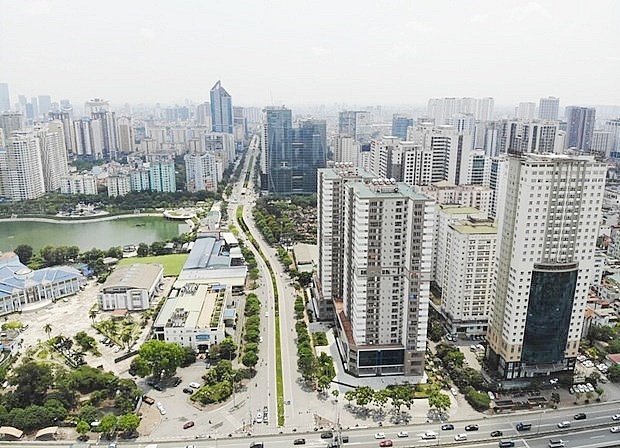Ring road plan to transform market
 |
| Ring road plan to transform market - Illustrative photo (Source: VNA) |
The government has asked the National Assembly (NA) to consider and decide on the policy for investing in the ring roads to be located in the country’s two biggest cities.
Tran The Anh, sales director of Thang Loi Group, said that the land fund in inner cities is increasingly exhausted and prices are high, with investors turning to suburban real estate. “There is a thirst for houses for those living and working in Ho Chi Minh City in particular,” The Anh said. “The shifting trend of investors and individual financiers is also creating a new vitality for the real estate market in the suburbs.”
One of the issues discussed by NA delegates and experts is how to exploit the land fund around the two ring roads, which will soar in value. Already in many places, the price of land in the area has increased dozens of times over.
“Because the two routes will open up a vast land fund, the management of auctions of land use rights and construction planning needs to be carried out very strictly, ensuring compliance with the law,” said Ta Thi Yen, a deputy of the NA from Dien Bien province.
Meanwhile, Le Thanh Van, an NA deputy from Ca Mau province, suggested the government needs to exploit the land fund in the corridors of these traffic projects, especially in areas near industrial parks and urban areas, in order to collect different types of taxes and fees to cover the compensation and construction costs.
On June 16, the NA approved the investment schemes of Ring Road 3 in Ho Chi Minh City at more than $3.2 billion and Ring Road 4 in the capital at more than $3.7 billion, via the state budget and contributions under the form of public-private partnerships and build-operate-transfer.
Ring Road 4 in Hanoi will be divided into seven projects and have a total length of about 112.8km passing through Hanoi, Hung Yen, and Bac Ninh; while Ring Road 3 in Ho Chi Minh City has a total length of 76.3km, passing through Ho Chi Minh City, Dong Nai, Binh Duong, and Long An.
| Truong An Duong-General manager of Residential Frasers Property Vietnam
To attract foreign investors, a transparent land auction process will provide a fast and clear way to access land banks. There is an opportunity for overseas financiers to meet requirements for bidding, which should be focused on criteria such as strong finance, great city development experience, and already having projects in Vietnam. Besides that, social infrastructure and housing will be given top priority, which brings long-run development to integrated satellite townships. Social infrastructure and social housing development should have clearer policies for foreign developers. Based on developments around the world, integrated satellite townships do not just focus only on residential and commercial but also on other social infrastructures, to provide essential needs to end-users and create value and sustainability. The component between infrastructure and integrated satellite township brings new real estate development which contributes higher value to the whole country. Thanh Tran-Advisor, DFDL Vietnam Law
The Prime Minister has local authorities to assist with plans to exploit the land areas for urban development, services, manufacturing, high-tech, and other corporate business on both sides of the belt routes. The convenience obtained from transport infrastructure once completed would be a boon for additional foreign and local investment into the real estate sector, primarily industrial, commercial and residential real estate. Ring roads in other countries have also helped to lower carbon emissions by reducing traffic congestion and have significantly benefitted the populations living along such corridors by connecting them more easily to home, work, entertainment facilities, and parks. It is essential for Vietnam to improve its legal framework governing real estate, some of which is currently in the process of amendment. Additionally, central and local authorities need to further eliminate investment barriers so as to streamline admin procedures in order to save time for potential investors. Efficiently developing the land areas will depend on synchronous coordination between relevant localities during appraisal and approval of planning and land area planning, in order to ensure the areas are used to their greatest potential. David Jackson-CEO, Colliers Vietnam
The boost for infrastructure development, especially in key economic hubs, would enable trade, power businesses, connect workers, and connect supply chains, hence generating opportunities for growth. Experiences in other countries have shown that investment in transportation infrastructure would lead to population relocation and the development of new areas. Together with the increase in labour supply is the setting up of new industries and firms in the surrounding areas. All of these can induce further growth of residential, industrial, and commercial real estate in localities where ring roads go through and connect to. To maximise the economic and social gain from the development of these ring road projects, there are some examples to look into. Specific taxes can be levied in areas with high increases in property prices to help finance the ring road projects, support additional infrastructure development along the ring roads, or compensate for residents in areas impacted by the ring roads. Incentives can also be leveraged to encourage investments in the development of public infrastructure on new land areas. Yet, infrastructure development is not only about building roads, but also about telecommunication systems, freight railroads, energy projects, and pipelines, etc. Reliable infrastructure is necessary for the efficient movement of goods and services, leveraging connectivity and growth not only for Ho Chi Minh City and Hanoi but also for other regions as well. It also increases accessibility to employment, healthcare, and education, thus improving livelihoods. Hence, it would be good to look at a systematic, comprehensive, and sustainable development plan for these road projects. Angus Liew - Chairman, Gamuda Land Vietnam
At present, the supply of housing in Ho Chi Minh City is scarce and prices are rocketing. Meanwhile, people’s demand for housing is very large. Therefore, Ring Road 3 shortens travelling time from the provinces surrounding Ho Chi Minh City to the main economic centre, and will promote population stretch and the shift in real estate purchases from the expensive and scarce downtown to suburban areas, as well as the formation of new industrial zones. A lot of factories will be moved there because of the favourable rental cost. Along with approving the policy of developing the ring roads, the government should have a specific mechanism to optimise real estate resources along these roads. It can be actualised through the mechanism of providing clean land banks as well as clear and transparent planning. In terms of authorities, transparency and support for investors in accessing infrastructure planning information is necessary to attract investment capital. The urbanisation procedure of the land banks along the ring roads connecting the centre of major cities was formed in developed countries many decades ago. In different countries, there will be different lessons and consequences. However, overall, there are some general principles to ensure that this strategy is successfully carried out, such as having a long-term planning vision and commitment to investment in infrastructure and public transport networks from the central government to expand connectivity to the periphery. Dao Le Ha-Head of Business Development Knight Frank
One of the most recent case studies that we can learn from is the Nakhon Pathom-Cha Am Intercity motorway, a 109-km tolled road connecting Bangkok to Thailand’s southern provinces. The project has run into difficulties with land expropriation despite expectations of increasing provincial connectivity and limiting congestion to and from Bangkok. Learning from this, both local authorities and developers must look at the linkage of key infrastructure such as satellite cities, ports, and airports to pinpoint whether they want industrial and logistics projects or urban township projects to be developed. The sooner the government is clear about Ho Chi Minh City’s road project planning with a projection of land compensation, the better for specialised zone allocation for urban townships and industrial and logistics zones. The laws need to be synchronised and reasonable in terms of a legal framework to avoid overlapping and conflict, and the process would also benefit from the digitalisation of the land fund in question for more transparency and accuracy. Further, what is also required is the dissemination of processes and information, education, and updating current policies related to regulations for land acquisition and compensation to land and asset owners, through seminars, meetings, or on public media and social networks. |
What the stars mean:
★ Poor ★ ★ Promising ★★★ Good ★★★★ Very good ★★★★★ Exceptional
Related Contents
Latest News
More News
- Sun Group breaks ground on $2 billion Van Don casino complex (December 19, 2025 | 18:14)
- Rare, beautiful, sustainable: the mark of iconic real estate (December 19, 2025 | 08:00)
- Owner-occupied housing stabilises, paving the way for new growth cycle (December 18, 2025 | 17:04)
- Unlocking urban potential of smart cities (December 18, 2025 | 16:50)
- Green finance offers 'passport' for Vietnamese construction, building materials firms (December 15, 2025 | 08:00)
- Gamuda Land commit long-term investment (December 12, 2025 | 11:49)
- HITC ties up with Evolution to develop AI and hyperscale data centres in Vietnam (December 11, 2025 | 12:09)
- Real estate deals boom via high-profile names (December 08, 2025 | 11:32)
- Industrial segment shaped by M&As (December 08, 2025 | 08:00)
- The Privé sets the benchmark for luxury real estate (December 05, 2025 | 08:28)






 Tag:
Tag:




















 Mobile Version
Mobile Version